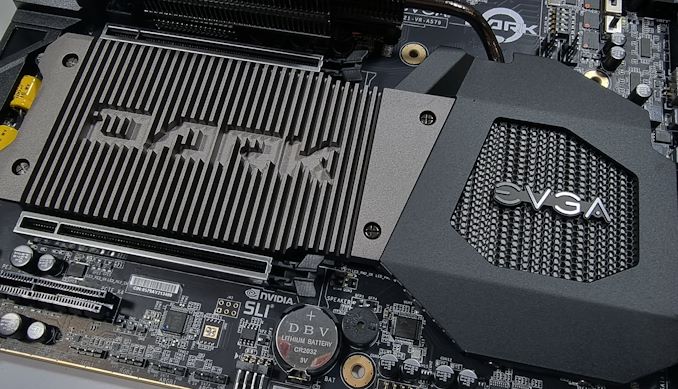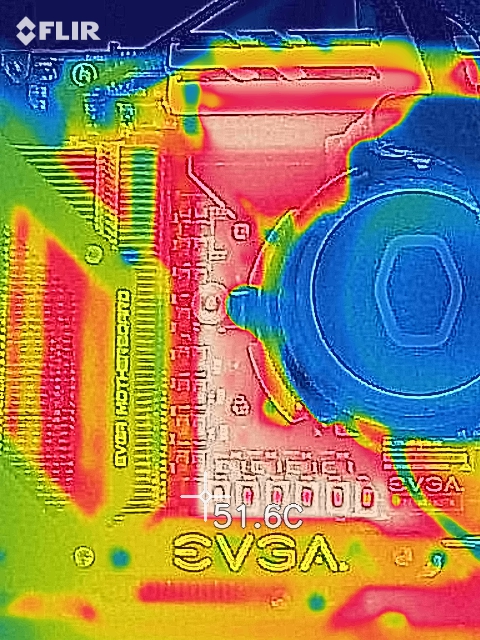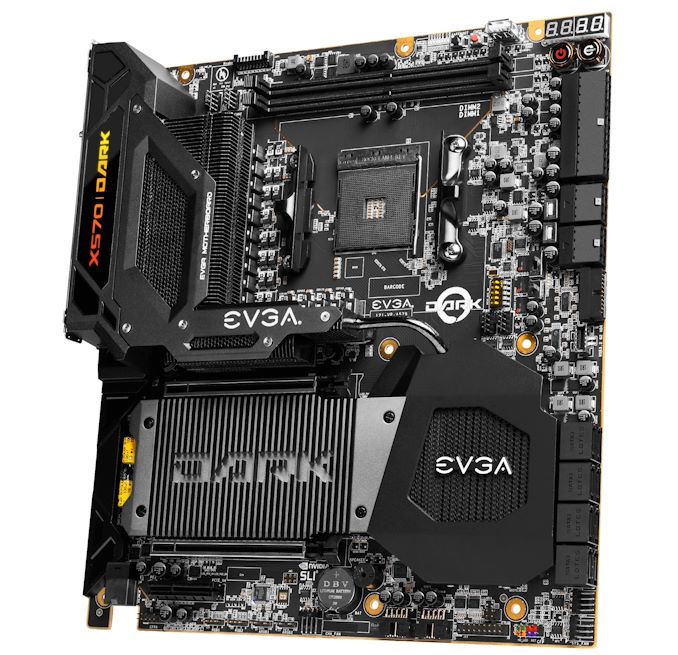The EVGA X570 Dark Motherboard Review: A Dark Beast For Ryzen
by Gavin Bonshor on October 8, 2021 8:00 AM EST
Quite a few of the motherboards we have reviewed over the last month have been aimed at enthusiasts with a penchant for extreme overclocking. Today's review focuses on the EVGA X570 Dark that is more than the usual desktop AM4 motherboard. It's EVGA's first entry into the market for AMD's Ryzen processors, focusing on performance and overclocking more than most other X570/X570S boards currently available. Some of the EVGA X570 Dark's most notable features include two memory slots with support for DDR4-4800, dual PCIe 4.0 x4 M.2, eight SATA, dual 2.5 GbE, and support for Wi-Fi 6. Is EVGA, which had previously been an Intel and NVIDIA only deal until now enough to tempt you to the 'DARK' side?
EVGA X570 Dark Overview: Ryzen Goes Dark
Vince Lucido, who is better known globally by his KINGPIN brand, isn't just one of EVGA's key employees but is also one of the most famous extreme overclockers. Back on July 12th, he uploaded an image on his personal Facebook page with a picture of a new Dark series branded motherboard captioned "The red pill." This interested the overclocking community, as Vince's creations are often used in achieving world records. The motherboard in the image not only displayed an AM4 socket but it showed something EVGA hasn't done since 2008; an AMD motherboard.
The EVGA X570 Dark teased by Vince "KINGPIN" Lucido on Facebook.
When EVGA offered us a sample of the X570 Dark to take a look at, I jumped at the chance to see what all the fuss was about. With it being EVGA's first AMD-based motherboard in over 12 years and not just at the entry-level or mid-range offering, EVGA drops its first motherboard for AMD Ryzen in at the deep end. Perhaps a combination of high confidence and successful motherboard launches on Intel's platforms, EVGA seemingly felt now was the time to bring its Dark series to the 'Dark' side.
Like its Intel flavored counterpart, the EVGA Z590 Dark, the X570 Dark follows many of the same design traits, with an RGB enabled logo built into the rear panel cover and a primarily black and silver design throughout. The EVGA X570 Dark also benefits from a passively cooled chipset consistent with other 'X570S' refresh models, which are all relatively new to the market. Perhaps the most notable of the aesthetical traits on the X570 Dark includes a transposed AM4 CPU socket, with the board's two available memory slots located horizontally across the top, which support up to DDR4-4800 and a maximum combined capacity of 64 GB.
Users wondering why so few memory slots for the size of the board (E-ATX), the memory slots have been designed for overclockers looking to try to break world records under sub-ambient cooling methods. The shorter tracks from the memory slots to the CPU socket should theoretically lower latencies for squeezing out those few extra benchmarking points.
Other design traits include a wide variety of right-angled power connectors and front panel headers around the board's edging, with an overclocker's toolkit in the top right-hand corner with dual two-digit LED debuggers power, etc. reset, Safeboot, and clear CMOS buttons. These are right-angled because they are less likely to get in the way during sub-zero record attempts, but for consumer use, larger cases are needed. Further towards the top left-hand corner is a Probelt voltage monitoring header, with cables to accurately monitor voltages in real-time supplied within the accessories bundle.
Looking at the core feature set, the EVGA X570 Dark includes a full deck of PCIe 4.0 support, including two full-length slots operating at x16 and x8/x8, a half-length slot electronically locked down to x4, and two PCIe 4.0 x4 M.2 slots. Other storage options include eight SATA ports, with six of these including support for RAID 0, 1, and 10 arrays. On the controller front, the X570 Dark includes two premium 2.5 GbE controllers and also has support for Wi-Fi 6. The X570 Dark also offers two USB 3.2 G2 Type-C ports, one on the rear and one header, with four USB 3.2 G2 Type-A, and support for up to six USB 3.2 G1 Type-A and two USB 2.0 ports. EVGA also includes an older, yet still premium onboard audio solution which is assisted by one of its NU audio headphone amplifiers
Performance Overview
Touching on the performance with is almost certainly EVGA's primary focus here, the X570 Dark performed creditably in all three areas of our testing, including system, compute, and gaming. Some users may be wondering why we've used an AMD Ryzen 7 3700X for our testing and not the flagship Ryzen 9 5950X, and the answer is simple, for comparison against other AM4 models tested. We saw no abnormalities in our power testing in our system tests, although the EVGA blitzed it in our POST time testing with one of the quickest boots into Window we've seen on AM4. In our compute and gaming tests, the EVGA X570 Dark, for the most part, came out on top in the majority in this testing. This shows EVGA has nailed down plenty of solid optimizations within the firmware, the hardware, and everything in between.
The clear focus from EVGA isn't just on making the best X570 board it could in terms of performance, but the X570 Dark is heavily engineered for overclocking. This is apparent in our testing, and the EVGA X570 Dark yielded some of the best potentials we've seen from ANY X570 board so far. We saw very tight levels of VDroop control on the CPU VCore with settings left on automatic, which shows EVGA's firmware is spot on. The biggest win for EVGA is that we managed a completely stable all-core overclock on our Ryzen 7 3700X of 4.4 GHz all-cores at 1.400 V on the CPU VCore. This is impressive and the only AM4 board we've tested so far that's managed to come close to this. On top of that, the VRM thermal performance is also one of the best we've seen, making the EVGA X570 Dark one of the best boards of this caliber we've seen so far.

The EVGA X570 Dark undergoing our VRM thermal testing
Considering the enormous bias on performance and extreme overclocking, the EVGA Dark X570's competition in the market comes from some of the more expensive X570 and X570S motherboards available. While the EVGA X570 Dark has an MSRP of $690, one of the competition models in this ballpark includes the latest ASUS ROG Crosshair VIII Extreme ($800), which has much more substance to it overall in both PCIe 4.0 and premium controllers but ultimately offers a much more well-rounded approach in terms of flagship AM4 models. For those interested, we also have the ASUS ROG Crosshair VIII Extreme in for testing, and our review of this model is coming soon!
Where the EVGA X570 Dark displays its uniqueness, it's almost designed primarily for extreme overclocking. With such a high-quality pedigree in this market already with its Dark series, it remains of interest to see if extreme overclockers can maximize AMD's Ryzen 5000 further over the coming months. For all of its overclocking traits, it also caters to those looking to run less aggressive cooling types with a decent, albeit not so competitive, feature set compared to the price over other models on the market. It's time to put the EVGA X570 Dark to the test and see what all of the fuss is about.
Read on for our extended analysis.












36 Comments
View All Comments
Eliadbu - Saturday, October 9, 2021 - link
Or RGB, but it has 2nd NIC and m.2 key E (incase you want to add wifi card).jtd871 - Friday, October 8, 2021 - link
AFAIK, RAM overclocking is more stable when you are using only 2 sticks, and this is a 'halo' board designed primarily for competitive overclocking.You wouldn't use a top-fuel dragster as your daily commuter car or to show up to a formal red-carpet event. In the same way, this board is not intended for 'normal' computing or gaming.
Threska - Friday, October 8, 2021 - link
Now I'm just waiting for the workstation/server version.WaltC - Friday, October 8, 2021 - link
I couldn't believe that I read this sentence in the review of this mboard:"While these comments make sense, ultimately very few users apply memory profiles (either XMP or other) as they require interaction with the BIOS."
There will be zero (0) customers of this motherboard who will decline to use the bios...;) Every single one of them will be quite conversant with the bios and eager to use it.
Seem to be a lot of this kind of general assumptions here that really have no relevance for the people who will be buying this product.
WaltC - Friday, October 8, 2021 - link
If I missed the place where you discussed a dual bios on this motherboard, or its lack of one, I beg pardon. But there are a lot of interesting DIP switches visible on this motherboard and a brief explanation would have been nice. Also, why would you test a 65W CPU with this board? Seems like a 5900X or 5950X would have been far more interesting, not to mention in keeping with the type of CPU a customer of the $690, OC'ing board is much more likely to purchase.I did agree with your conclusion, though, about boards costing half as much having very similar features and options--for instance, my two-year old x570 Aorus Master ($350) includes both the RT 1220-VB HD & a headphone AMP for onboard sound, but the x570 Master also includes a hardware DAC, the SABRE 9118, while the EVGA board lacks a hardware DAC. The Master includes 4 DIMM slots, and a manually switched dual-bios setup--which in my estimation is just about a requirement for an overclocking board--which the Master is, even though it doesn't have the VRM chops of this EVGA board. But my Master was shipped on the same day that Zen2 CPUs shipped from AMD, so I think the EVGA board is targeting upper-end Zen3 CPUs for OC'ing.
But as I mentioned earlier, trust me when I say that nobody will be buying a $690 OC'ing board who is afraid to go into his bios...;) Glad to see EVGA supporting AMD again, and like you, it will be nice to see a range of AMD4/5 EVGA board products at some point.
Oxford Guy - Saturday, October 9, 2021 - link
"While these comments make sense, ultimately very few users apply memory profiles (either XMP or other) as they require interaction with the BIOS."Stuff like this is a gift (of hilarity) that keeps on giving.
Silver5urfer - Friday, October 8, 2021 - link
There are few things, first this board doesn't use ASM SATA controller, I think you should correct that. All 8 SATA ports are from chipset only. The extra PCB for LN2 also shows the same, Manual also states the same.Now moving on to the board vs Z590 DARK. They removed one NVMe M.2 slot on this, Downgraded the phases and smaller Aluminum heatsink instead of massive Copper block on Interl board, then we have the rear DP and HDMI removed.
Next, the bigger things. First is the USB ports, the board has rear I/O from Chipset only. None of them are from CPU. Usually all X570(S) boards have ton of CPU USB ports, EVGA chose not to for this board. I can guess the only reason being AMD Ryzen 5000 CPUs have issues with the USB ports dropping and all sort of bugs, still not ironed out. So they avoided those, but the front I/O panel ports will be from CPU only, on top they dropped the ASMedia controller for USB C unlike the Z590 DARK. They also dropped the U.2 port.
Next is why they did they go with the Dual DIMM slots, Ryzen doesn't do well with Dual Rank B-Die kits unlike Intel which likes them. Now we have to be too cautious on that part due to the Zen 3 IMC. Now the price, it's highway robbery period. The board is exactly priced at X570 Aorus Xtreme at $700 which not only packs everything this has but even more. Plus it also has the 10G LAN, on top of the HiFi DAC which is not that buggy trash ALC4080 class, instead ALC1200 like this. Crosshair VIII Extreme is $100 more but it has more features, however it has that dreaded garbage ALC4082 and all that ASUS bloatware for the proper functioning of the DAC/AMP hardware. These guys should have included a 10G LAN port at-least, they really are saving a ton of cash on this board, simply a Z590 DARK based PCB design with extra PCIe 4.0 M.2 drive and much more reduced components and choices vs Intel board.
Coming to review, surprised on the DPC latency of this board. Now I'm just waiting on how this board does, esp related to the AMD Ryzen stability with Memory and OC AND USB. Also it's a shame that there's no Ryzen 5000 used for review and no Memory tuning as well. Everything this board got going is all about OC and unlocking potential...
leexgx - Friday, October 8, 2021 - link
If you use 2x dual rank sticks (anything above 16gb per stick) is exactly the same as using 4x8gb single rank sticks (because it's in dual rank due to 2 single ranks per channel)The point of this motherboard is for lm2 overclocking is why there is 2 slots
Slash3 - Saturday, October 9, 2021 - link
EVGA's specifications page does still list two ASMedia SATA ports, and they were incorporated on the Z590 and other, previous Dark boards for XP compatibility. It's possible that they were on internal or pre-release samples but then removed for the retail version.PsychoOC - Friday, October 8, 2021 - link
Whats ironic is the world record holder for most ln2 benchmarks on 3700x is on b450 tomahawk;)